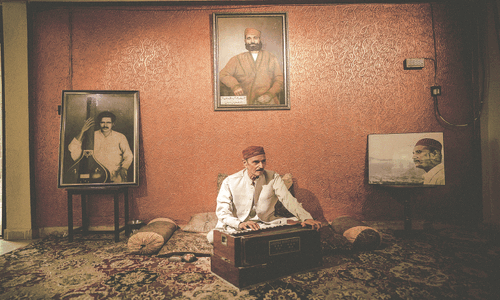
This fascinating story needs retelling, particularly for the younger generations in Bangladesh, who would take pride in knowing that a fairly sizable portion of one of the most successful, Academy Award (Oscar)-winning, blockbuster epic movies of Hollywood of the 1950s, Around the World in 80 Days (1956), was filmed at selected locations of Sreemangal, in Sylhet and Barabkunda, in Chittagong. And that, in those immensely difficult days of road communication and a host of other logistical problems, an indefatigable gentleman from Dhaka, G.M.M.E. Karim, rose to the occasion by volunteering his services to render shooting of the film possible and on schedule.
The resourceful and multifaceted Karim, besides being an accomplished professional, was also a big game hunter in his younger days — he shot his first full grown tiger in 1941, in the United Provinces of British India — knew the jungle lore by heart, was an avid photographer, a documentary filmmaker and a pioneer nature and wildlife conservationist of the country. So much so, that the World Wildlife Fund appointed him as its first Honorary Consultant for Conservation in Bangladesh, in 1973. He was also an early exponent of tourism in the country.
It was Karim’s untiring efforts which made it possible to arrange for a herd of elephants, with the assistance of the former zamindar estate of Prithimpassa, in Sylhet, and the requisitioning of a passenger train drawn by a vintage hooting, chugging, smoke-belching steam-locomotive from the railway authorities, for filming of the East Bengal sequences of the movie, Around the World in 80 Days.
Around the World in 80 Days was a wildly successful film that won five Oscars in an Oscar-winning Hollywood film set up shop in what used to be a part of Pakistan
While recounting his unique experiences, he reminisced in his personal papers: “It was thrilling to see a great classic being filmed and myself being a part of it. You can well imagine the odds against the task in those days. The communication was so bad and the places where we chose to shoot were so inaccessible. But we had it all done in 22 days — the scene of the train stopped by a herd of wild elephants going across the track, the Satidaha (Suttee) and the sacred cow — all that was supposed to be happening elsewhere in British India. Well, as for myself, I did not tell anyone and there were no film magazines during that time.”
For the duration of the shooting of the movie, the cast and crew were booked at the Shahbagh Hotel in Dhaka, then a spanking new modern hotel in the city, built in the early 1950s. It was a six-storied building without elevators, but otherwise spacious, airy and clean. At first look, it seemed something out of a Graham Greene novel.
The art-deco entry portico led into a foyer with a high ceilings supported at intervals by tall, monolithic, rounded columns. Most of the available rooms on the topmost floors, with long shaded verandas, were reserved for producer Michael Todd, stars Shirley MacClaine and David Niven, associate producer Kevin McClory and others of the film unit. Although every room had an attached bathroom with modern sanitary fittings, there was no running hot water. On order, bearers had to haul hot water up the staircase in metal buckets for the guests to take a bath.
The double bedrooms with twin four-poster beds looked almost regal draped in white mosquito netting. A bearer was attached to each room to take orders from guests and run errands. He was also responsible for regular dusting, sweeping, swabbing and bed-making, in addition to draping and un-draping the mosquito nets when the guests went to sleep or woke up.
All the meals at the hotel had to be taken in a banquet-sized dining hall on the ground floor, with large overhead whirling fans. A person of short stature, dressed in a white uniform with a fanciful turban, dutifully opened the doors to guests with a polite grin. He would bow low while giving a salaam (greetings). His courteous overtures were adequately reciprocated by the diners with a generous tip.
In the dining room there was a raised platform at the front, where an aged Anglo-Indian man played the same melodies on alternate evenings on an old piano. On other days, during lunch and dinner, a Goan orchestra from Calcutta played “ancient” Western tunes, on decrepit musical instruments. One ate meals to bygone musical hits of the 1920s such as Five Foot Two, Eyes of Blue, Melancholy Rose, West End Blues and Swanee. The hotel also boasted of having the best delicatessen in the city.
From the commanding height of their hotel rooms, especially from the rooftop, the Hollywood film crew had an expansive view of Ramna with the quaint red-brick colonial bungalows on Minto Road, set amidst a vast stretch of verdant foliage, all very beguilingly picturesque, serene and sublime. They were enchanted by the pristine, enthralling beauty all around.
The nearby Dhaka Club, just a brisk walk away was an added attraction, where the crew would often go for a quick drink. Needless to say, their august presence enlivened the club’s atmosphere. Across from the languorous ambience of the club, one could espy the smooth golf links of the Ramna Green and its white-fenced horseracing turf. Also visible through the shimmering wintry haze, as if in an illusion, was the noble eminence of the historic Ramna Kalibari [temple], beside the placid serpentine lake.
Now a word about the novel and the movie Around the World in 80 Days, an adventure-comedy film produced by the Michael Todd Company, and released by United Artists in 1956. The picture was directed by Michael Anderson with Kevin McClory and William Cameron Menzies as associate producers. The screenplay was written by James Poe, John Farrow, and S.J. Perelman based on the classic adventure novel of the same name by the French writer Jules Verne, published in 1873. It is Verne’s most acclaimed work.
The movie had a star-studded cast, with David Niven and the famous Mexican-comedian Cantinflas in the lead roles of Fogg and Passepartout. More than 40 performers made cameo appearances in the movie, an all-time record for any Hollywood movie. Reportedly, it made a US Screen Actors’ Guild representative cry out in amazement to the producer: “Good heavens Todd, you’ve made extras out of all stars in Hollywood.”
The filming of the movie took place in late 1955, from August 9 to December 20. The picture cost just under six million dollars to make, employing 112 locations in 13 countries and 140 sets. The film premiered on October 17, 1956 at the Rivoli Theatre in New York City. By the time of Todd’s accidental death 18 months later in a private plane crash, it had grossed an astronomical sum of 33 million dollars, unprecedented for those days. The movie was shown in Dhaka in 1962, at the most popular Cinema Hall called Gulistan, with much fanfare and to great success. It was a memorable event and the city was agog with talk of it for months afterwards.
The film was nominated for eight Oscars, of which it was awarded five, including the Best Picture, beating out critically acclaimed, publicly praised films, such as Friendly Persuasion, The Ten Commandments, Giant, and The King and I. The film was also nominated for three Golden Globes, of which it effortlessly bagged two.
Waqar A. Khan is the founder of Bangladesh Forum for Heritage Studies — By arrangement with Asian News Network/Daily Star
Published in Dawn, ICON, April 28th, 2019


































